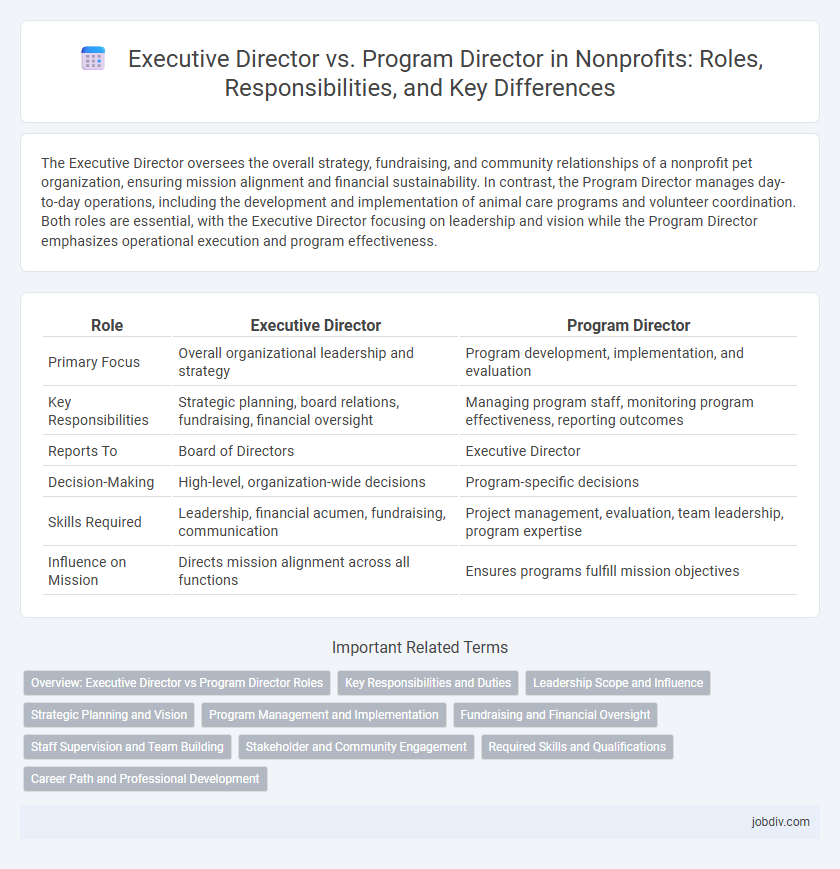The Executive Director oversees the overall strategy, fundraising, and community relationships of a nonprofit pet organization, ensuring mission alignment and financial sustainability. In contrast, the Program Director manages day-to-day operations, including the development and implementation of animal care programs and volunteer coordination. Both roles are essential, with the Executive Director focusing on leadership and vision while the Program Director emphasizes operational execution and program effectiveness.
Table of Comparison
| Role | Executive Director | Program Director |
|---|---|---|
| Primary Focus | Overall organizational leadership and strategy | Program development, implementation, and evaluation |
| Key Responsibilities | Strategic planning, board relations, fundraising, financial oversight | Managing program staff, monitoring program effectiveness, reporting outcomes |
| Reports To | Board of Directors | Executive Director |
| Decision-Making | High-level, organization-wide decisions | Program-specific decisions |
| Skills Required | Leadership, financial acumen, fundraising, communication | Project management, evaluation, team leadership, program expertise |
| Influence on Mission | Directs mission alignment across all functions | Ensures programs fulfill mission objectives |
Overview: Executive Director vs Program Director Roles
The Executive Director oversees the nonprofit's strategic vision, fundraising, and overall organizational management, ensuring long-term sustainability and stakeholder engagement. The Program Director manages the design, implementation, and evaluation of specific programs, focusing on operational effectiveness and impact measurement. Both roles are critical; the Executive Director leads at the macro level while the Program Director drives mission delivery on the ground.
Key Responsibilities and Duties
The Executive Director oversees the nonprofit's strategic vision, financial management, and external relations, ensuring organizational sustainability and compliance. The Program Director manages the development, implementation, and evaluation of specific programs, focusing on program effectiveness and staff supervision. Both roles require leadership and coordination but differ in scope, with the Executive Director focusing on overall organizational governance and the Program Director concentrating on operational program success.
Leadership Scope and Influence
The Executive Director oversees the entire nonprofit organization, making strategic decisions that shape the mission, finances, and stakeholder relationships, thereby holding the highest level of leadership influence. The Program Director focuses specifically on managing and developing individual programs, ensuring alignment with organizational goals but operating within a more specialized leadership scope. This distinction in leadership scope and influence highlights the Executive Director's role in broad organizational governance versus the Program Director's responsibility for programmatic impact.
Strategic Planning and Vision
The Executive Director drives the nonprofit's strategic planning and vision by aligning organizational goals with the mission and external opportunities to ensure long-term sustainability. The Program Director focuses on implementing these strategic plans within specific programs, translating the overall vision into actionable objectives and measurable outcomes. Strategic oversight by the Executive Director enables cohesive leadership, while the Program Director ensures programmatic alignment and impact effectiveness.
Program Management and Implementation
The Executive Director oversees overall strategic direction and organizational leadership, ensuring alignment with the nonprofit's mission and long-term goals. The Program Director focuses on program management and implementation by designing, coordinating, and evaluating specific initiatives to meet community needs effectively. Strong collaboration between these roles enhances program impact and operational efficiency in nonprofit organizations.
Fundraising and Financial Oversight
Executive Directors in nonprofits primarily oversee strategic fundraising efforts and ensure overall financial sustainability, including budget approval and financial reporting. Program Directors focus on managing specific projects, aligning fundraising initiatives with program goals, and monitoring expenditures within their program budgets. Both roles require collaboration to maximize resource allocation and achieve fundraising targets effectively.
Staff Supervision and Team Building
The Executive Director oversees the entire nonprofit organization, providing strategic leadership and supervising senior staff, including Program Directors, to ensure alignment with organizational goals. Program Directors focus on managing specific programs, directly supervising program staff and facilitating team building within their departments to enhance project outcomes. Effective collaboration between Executive and Program Directors strengthens staff supervision and fosters a cohesive, high-performing nonprofit workforce.
Stakeholder and Community Engagement
The Executive Director spearheads organizational strategy and establishes high-level partnerships, ensuring alignment with stakeholder interests and broad community goals. In contrast, the Program Director focuses on managing program delivery and fostering direct relationships with beneficiaries and local community groups. Both roles are crucial for effective stakeholder engagement, with the Executive Director emphasizing vision and external alliances, while the Program Director drives community impact through hands-on involvement.
Required Skills and Qualifications
Executive Directors in nonprofit organizations must possess strong leadership, strategic planning, and financial management skills, often requiring advanced degrees in business or nonprofit management alongside extensive experience in organizational oversight. Program Directors need expertise in program development, evaluation, and community engagement, typically holding degrees in social sciences or related fields and demonstrating a track record of successful project implementation. Both roles demand exceptional communication and team management abilities, but Executive Directors focus more on high-level decision-making and resource allocation, while Program Directors prioritize program execution and impact measurement.
Career Path and Professional Development
Executive Directors in nonprofits typically advance from Program Director roles, gaining strategic leadership skills and organizational management experience essential for overseeing all operations. Program Directors develop expertise in program design, implementation, and evaluation, serving as subject matter experts before transitioning into broader administrative responsibilities. Professional development for both roles includes training in leadership, fundraising, and stakeholder engagement to support effective nonprofit management and career advancement.
Executive Director vs Program Director Infographic

 jobdiv.com
jobdiv.com